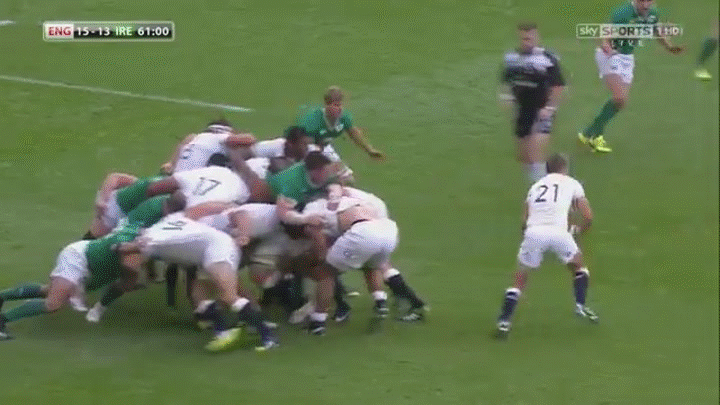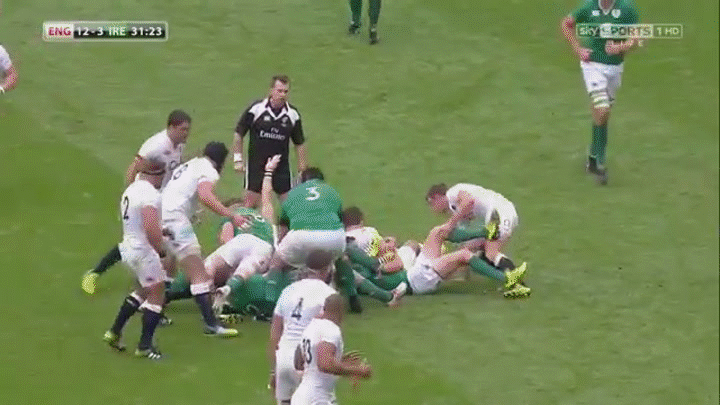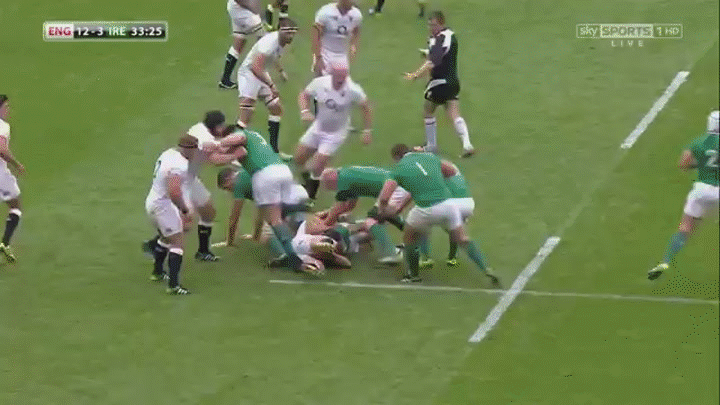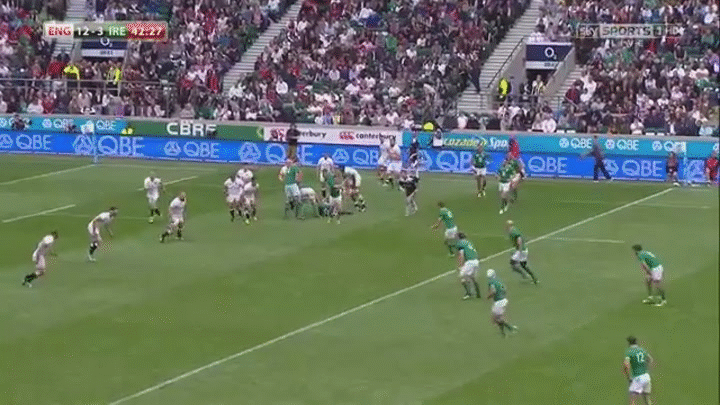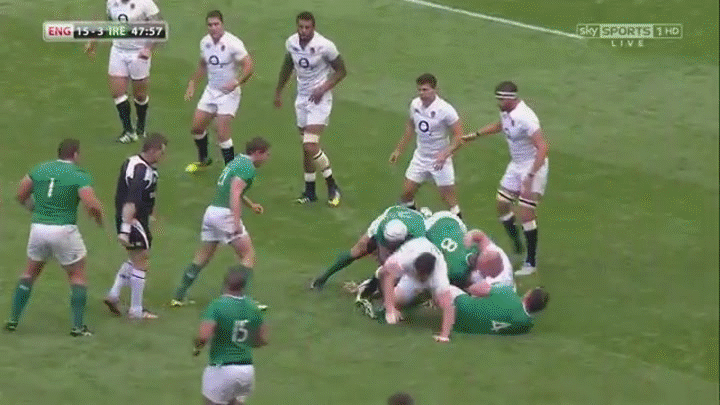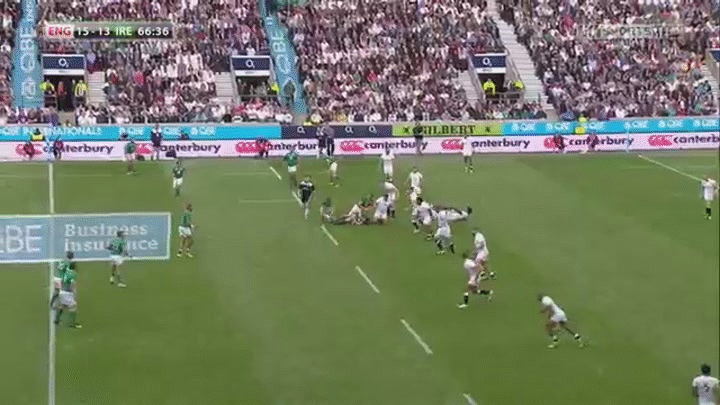The theory of everything
"The theory of aerial bombardment is one of the great tactics of Irish rugby". Sky Sports analyst Stuart Barnes during last Saturday’s loss in Twickenham.
Rightly or wrongly, there now seems to be a collective agreement in world rugby that the bulk of Ireland’s attacks are through the air. The roles of wingers, centres and, to a lesser extent, fullbacks have been re-defined during Joe Schmidt’s tenure and Ireland has reaped the rewards.
The problem is that the ‘theory’, as Stuart Barnes called it, is becoming increasingly difficult to put into practice. In the last two warm-up matches, Ireland’s opponents have been more than capable of dealing with the high, hanging balls that they have been sent raining down on their back-three. Indeed, at times it appeared as though the English and Welsh defences were more than happy to focus on their fringe defending and simply wait for Ireland to put up a box-kick or a Garryowen.
One Englishman to every Irish ruck and still it's slow ball. The rest fan out knowing a green jersey will eventually kick it.
— Gavin Cummiskey (@Cumoski) September 5, 2015
Ireland’s reliance on Johnny Sexton as playmaker and their reluctance to gamble on off-loading is making them a much more predictable side to contain. The handful of sliced kicks, misplaced passes and knock-ons from Sexton during the past two games were often attributable to the severe pressure that he was under. Defences are aware that if they can cut-off Sexton, then Ireland lack creativity further out to cut them open. Choke Sexton and you choke the Irish attack.
During this year’s Six Nations, Schmidt attempted to give his side more midfield options by bringing Simon Zebo or Tommy Bowe off their wings to give opposition defences something new to think about. Zebo’s footwork or Bowe’s straight line speed would often manufacture some extra space or an overlap that Ireland could exploit. We haven’t seen much of Ireland’s wingers in more central positions during this warm-up series and it could well be that they will be more involved during the World Cup.
However, the real root of the problem is that Ireland’s centres either aren’t being given the chance to unlock defences or they don’t have the tools to do it. For close to 15 years, Irish teams were blessed with a creative fulcrum at outside centre, a player who could assess his options and play what was ahead of him and bring other players into the game. In the absence of that type of player, more pressure is being placed on Sexton to stand at first receiver and then, somehow, get himself into more open territory using those looping runs of his to repeat the trick again.
Unlucky no.13
Jared Payne is the guy who has been burdened with taking over the no.13 jersey in Irish rugby and he’s been an unqualified success when it comes to the defensive side of the game. Whenever we spoke to Brian O’Driscoll about the mentoring work he was doing with both Payne and Robbie Henshaw during his final season, it was inevitably the defensive reads that he was most concerned about - learning how to transition from being the last line of defence as a full-back to becoming a leader of the defensive line.
Payne forced two turnovers last Saturday against England and missed just two tackles, making 12 successful tackles, which was the third highest in the Irish stats, and included a choke tackle in the opening quarter that stalled the English momentum. If anything, his tackle-rate appeared to increase during the closing stages when the rest of the Irish side started to tire - making crucial stops on Mike Brown and Anthony Watson during the final quarter when they had beaten the first defender.
However, it’s fair to say that the Ulsterman had a mixed-bag when it came to the attack, mixing some good decisions with some poor lines and passes.
Such was England’s early dominance, Payne’s first real involvement in an attacking sense was after Dave Kearney’s aggressive defence forced a turnover off George Ford. After identifying the space behind the English line, he’s quick to exploit it with a well weighted grubber that he, Kearney and Zebo follow-up on and England concede a penalty when Joe Marler dived on the ball from an offside position.
If that piece of improvisation demonstrated Payne’s ability to react to what he sees ahead of him, he (and Schmidt) will have been disappointed with his next contribution. A long pass from Eoin Reddan, followed by a quick transfer by Sean O’Brien has left him in some space inside English territory. But with runners both inside and outside of him, Payne is trying too hard to get outside the English defence and forces a long pass out to Tommy Bowe that is not only forward but is also too far in-front of Bowe for the winger to control effectively.
Oddly, Ian Madigan spoke about this very scenario in an interview on Off the Ball just last month, which I’ve already discussed in an earlier blog post and so it’s likely that Schmidt will have had Payne staying behind after training this week to practice his long passing!
Shortly afterwards, Payne is given another chance to run an Irish backline play as Peter O’Mahony plays a pass out the back that gives his outside centre the chance to attack the English line from deep. His arcing run towards the left not only brings him closer to Robbie Henshaw, but also has the effect of drawing England’s Anthony Watson off his wing and leaving Dave Kearney in space.

Next up is an offload that shows how Payne can be used as an attacking fulcrum further outside. A loop play involving Sexton actually allows Payne to push further to the left and he shows exquisite timing and dexterity to draw Watson and George Ford before popping the pass that allows Kearney to make some metres up the wing. Crucially, he also follows-up to provide the clear-out that keeps the attack flowing.
The last flashpoint I wanted to look at was inside the final quarter when Ireland had closed to within just two points of an English side that had dominated them, but had failed to take their chances to finish-off their opponents. An Irish score here could well have destroyed England’s confidence.
At the start of the move, you can see that Payne is standing deep and is pointing in the direction he wants the players outside him to move as he waits to eventually receive the ball from Ian Madigan.

Once again, when he gets possession he’s got time and space to attack from deep which allows him to show the running threat that he developed as a full-back before his conversion to the centre. This time, he spots that England have numbers to spare outside of him and that Jonathan Joseph has come-up out of the line and could have left a gap which he could exploit. He actually picks the right option and breaks a weak tackle from Sam Burgess to get over the gainline and it requires a brilliant piece of defending from Joseph to force the offload.
Conclusion
Payne is unlucky in this case, but you suspect that Schmidt would have accepted his reading of the situation. The point is that the no.13 is being given a role as a key playmaker in the Irish midfield and he hasn’t capitalised as he would have liked to.
After both Keith Earls and Luke Fitzgerald got a chance to try-out at for the role during this warm-up series, it’s possible that Joe Schmidt is still considering his options at outside centre and Payne will have to step-up his creative involvement if Ireland are to become less one-dimensional.
Download the brand new OffTheBall App in the Play Store & App Store right now! We've got you covered!
Subscribe to OffTheBall's YouTube channel for more videos, like us on Facebook or follow us on Twitter for the latest sporting news and content.



